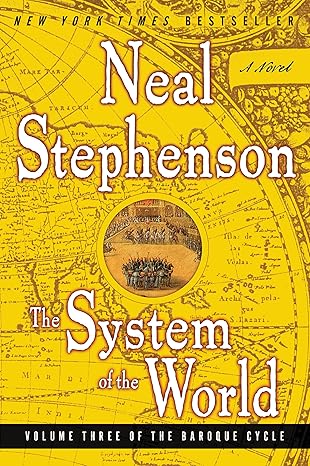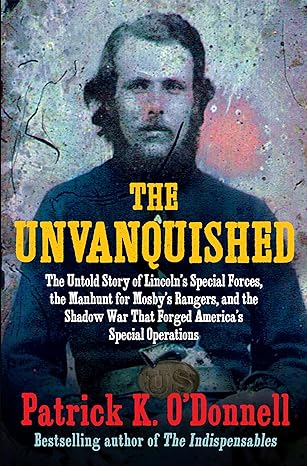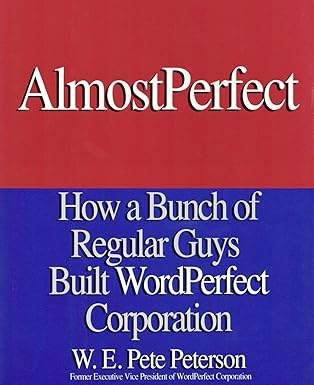 ISBN: 978-0060750862
ISBN: 978-0060750862
Paging back through this site, the first review in this three part book series was posted in November of 2023. Though it was not seven months of steady reading, it does speak to the size and scope of the series. Roughly 3,000 pages are what Stephenson wrote to tell this story.
Sometimes, one feels that some of those pages were wasted in displaying the research that was so assiduously conducted on the layout of buildings like the Old Bailey or Newgate Prison. On the other hand, these details do make the series have a more immersive sensation since it is clear that Stephenson is not simply writing about these places, but has obviously been to them.
The haunting refrain in this particular book concerns the Quicksilver that Daniel Waterhouse finds himself still concerned with, although most all the Alchemists have exited the scene and what remains is a new kind of Alchemy which no longer mentions items like the Philosopher’s stone. Instead, everything has taken on a different shape in the form of currency and technology. The person at the center of this new machinery is none other than Issac Newton. Newton has been relegated to overseer of the mint where all the new coins of England are to be made. Jack Shaftoe, however, now “Jack the Coiner” has been sent by the King of France to spoil this plan, and has resources in the form of the sought after Alchemical gold of Solomon.
This new system, is of course, supposed to change the entirety of the world and only one person, Princess Sophia, has a vision of the consequences if it happens to be somehow wrongly conceived. The form that vision assumes is a globe consumed by fire and left as a lifeless, black orb.
Throughout the work, each character is driven by something that they are not going to get on the terms that they want. The Solomonic gold is wanted by Newton, for instance, but he finds himself unable to get it and is instead having to work against it since his adversary is using it to undermine the currency he is developing. Jack Shaftoe really only wants to be with the Duchess, but it seems that the only thing he can do is get himself bogged down with people that have other motives that want to use him and the gold he has access to for their own ends. Peter Hoxton, a thief of watches who turns assistant to Daniel Waterhouse, really only wants to steal enough to make some money but instead winds up ensnared in a form of Apocalyptic timeline that Waterhouse was raised to believe would happen. Instead, Waterhouse becomes an atheist from interacting with the arising sciences that develop.
Throughout the novel there is speculation about what true gold is, what good it is to anyone, what Alchemy is and where does it begin and where does it end. Waterhouse summarizes near the end of the tome for us adroitly:
“It has been my view for some years that a new System of the World is being created around us. I used to suppose that it would drive out and annihilate any older Systems. But things I have seen recently, in the subterranean places beneath the Bank, have convinced me that new Systems never replace old ones, but only surround and encapsulate them, even as, under a microscope, we may see that living within our bodies are animalcules, smaller and simpler than us, and yet thriving even as we thrive.”
Indeed, the novel is full of one system foreshadowing another which leads to the next round of alliances, fallouts, and treachery.
While the Industrial Revolution begins to take off, the problem of slavery still looms. While the idea of a computer develops between the warring parties of both Newton and Leibniz, the practicality of how to achieve it is still distant as the “underground river” has not matured enough to allow for the kinds of inventions necessary to make these technical marvels a full reality. While there are fortunes to be made, there is money to be lost as monarchies rise and fall and alliances change. Timing, climate, finance, trade. All of these variables are constantly changing and being reassessed.
Stephenson masterfully tells the tale, but at times it requires the reader to do a bit too much work. Some passages require several readings to infer that an obvious event has happened. This is part of Stephenson’s style, but the oblique references are sometimes a bit too understated, and so one will read along to discover that they missed some subtle nuance that changes the course of the reading. Oftentimes, the nuance is not present until a future chapter, and so one spends time trying to figure out things that have not yet been fully revealed but are being instead hinted toward. A little of this, of course, makes for interesting reading whereas too much proves frustrating. One needs the message to be direct enough that a casual reading is sufficient to parse the message, unless one wishes to be read in college literature analysis courses. Perhaps that is partly Stephenson’s goal, but it seems doubtful. Put differently, the work is brilliant, but it would be more brilliant if the author tried to be less brilliant. Jack Shaftoe ought to point the way on how to do that.
Concerning the ending of this series, there are many things one could say. It definitely feels like a conclusion to a long, winding adventure. The pieces fit together well enough, and it is nice to see how the characters resolve their outstanding issues. Like the trial of the Pyx, the device used to make sure the currency of England is sound, we have a sense in which everyone is being “weighed” in the balance and that the conclusion will be final when the measurement is made. Probably, anyone who has read the series feels a little like Doctor Waterhouse at the end. Of course, that feeling might be tempered by the fact that Stephenson has left us a System of Writing about the World, and while it might not be perfect, it is better that the tale was told and exists than having no System at all. The only trouble is, one never knows what else is hidden in the walls of Bedlam, or in what language whatever is found might be written in should it chance to be discovered.
Perhaps, the System of the World is thinly controlled insanity and the only outcome, when the Solomonic Gold is divorced from God, is for it to burn with a fever until the dreamers are snapped out of their sickened reveries. If so, The System of the World is definitively an attempt to tell the tale while the body hallucinates.
 ISBN: 978-0802162861
ISBN: 978-0802162861
Patrick K. O’Donnell has tackled an obscure corner of history. In part, this history is obscure because it is at the roots of America as a country. The other part of this relatively occulted subject occurs because the topic concerns clandestine units that operated spy rings during the Civil War.
The two units focused on are the Northern Jessie Scouts, and the Southern Rangers. Both of these units dress up in the other army’s colors with the objective of gathering intelligence, gaining kills, and taking prisoners. The phrase “All is fair in love and war”, springs to mind.
At times, it is hard to keep track of which units are impersonating who. Fortunately, there is an index in the back that lists the characters and their affiliations. If the reader knows this going in, it probably will prove a necessary and valuable asset to ameliorate this potential issue. If not, one often has to read the context carefully to be sure one is remembering who is on what side. It is not always easy either to keep track of who has actually changed sides and who might be a double agent.
Nonetheless, O’Donnell is advancing several conclusions in this work. The biggest piece which stands out concerns who knew what and when where the assassination of Lincoln took place. It is not especially giving a spoiler to say that the conclusion he draws is “many units of the South”. The reason this is not the spoiler one might imagine is that how O’Donnell arrives at this deduction concerns analying many convuluted movements and communications occurring within the Southern armies–particulary during the waning days of the war.
The next important thesis concerns how the movements of the Rangers under Mosby are used as a type of instruction manual for irregular warfare units during World War II as practiced by the OSS. (Office of Strategic Services)
A definition might prove valuable here for the casual non-military reader concerning irregular warfare and regular warfare (conventional):
“Irregular warfare (IW) is defined by the Department of Defense as “a violent struggle among state and not-state actors for legitimacy and influence over the relevant populations. IW favors indirect and asymmetrical approaches, though it may employ the full range of military and other capabilities, in order to erode an adversary’s power, influence, and will.” source: https://www.red-inc.us/irregular-warfare/overview/
In other words, irregular warfare involves spy and psychological kinds of operations. Conventional warfare, on the other hand, is more direct with various members of both armies attempting to obliterate one another on the battlefield using traditional weapons.
If you mix the two together, the result is a “hybrid” kind of warfare which uses both methods of battle with the goal being the ultimate victory of one side or the other.
Mosby’s rangers are very good at this kind of warfare and use what might be an early form of blitzkrieg method of attack utilizing calvary before disappearing into the surroundings. The North develops intelligence gathering ability, however, through the intervention mostly of a man by the name of Phillip Sheridan. Sheridan would eventually go on to become a four-star general. The North wins mostly by gathering intelligence. The South gains many of its victories owing to Mosby’s lightning fast guerilla tactics. Both, of course, were adopted in military strategies on many sides in future wars.
The South is also not without its intelligence units and respective secret services, but it seems they are often inefficient in the narrative or else are simply outmanuevered or outmanned. Often, however, their plans do not succeed by very narrow margins. O’Donnell does a great job of illustrating these kinds of moments and includes a story about one officer who might have changed the outcome of the war simply by having gone fishing.
One thing missing from O’Donnell’s account which plays a part into this story is how not just Lincoln’s enemies conspired to kill him. Indeed, there were many that called themselves friends of Lincoln who behaved quite strangely before his death. More than a few were in close proximity to people like Booth and mixed among him and people like Lewis Powell. Everyone wanted to become rich on cotton, and the South had a lot of it to sell. Many wanted Lincoln out of the way, because he was not radical enough in his positions for either the North or the South. So while the thesis of the book points to the death of Lincoln being heavily a Southern invention, the subsequent actions of many in the north who wanted to be President and have power to rebuild the nation after the civil war cannot be overlooked or understimated. What O’Donnell does well, however, is establishes that many in the South were playing ignorant of a desired outcome to evade justice. All of them, in this work, look guilty. They surely were not lacking in apparatus to organize insurrections which they pursued, and they definitely were not wanting when it came to organizing something on the scale of an assassination. That many were not held liable for this is the blind eye history likes to turn in changing the page to the next moment of peace before conflict.
url: http://www.wordplace.com/ap/  ISBN: 978-0788199912
ISBN: 978-0788199912
This review is written in markdown in WordPerfect 8 within a Linux terminal. This is not taking place due to a sense of nostalgia so much as it is appropriate to the review in focus.
Many of us, including the reviewer, have used WordPerfect at one point or another. Markdown, is, in many ways, the answer to what was lost when Microsoft Word began to replace WordPerfect. WordPerfect has something that modern word processors lack–a user can push a button marked “Reveal Codes” and once this is done begin to understand what “hidden formatting” is present in the document that might be causing formatting issues.
The book “Almost Perfect,” by W.E. Pete Peterson, tells the tale of how WordPerfect rose and eventually fell on its own sword. What makes the tale especially interesting is that it traces the narrative through a time when business was just beginning to migrate from traditional goods, in Peterson’s case, a family-owned drapery business, to ‘adoptive families’ via technology companies. The old models of making money were beginning to become difficult to maintain, and the new models were in the digital frontiers and had better profit margins.
Peterson, though, tries to maintain what he considers to be a “fair” balance between running the company, and having friends while earning outrageous amounts of profit. He was, quite literally, following his dreams and would eventually have more than enough money to gather if only he had enough hands to help him gain it.
Within the company, the predictable story of the original founders, not really understanding what they are doing and quickly discovering an entire world of money and logistics and personality conflicts, comes into view and to deal with this issue Peterson builds a scaffolding that proves to be his legal undoing later when the company decides it wants to remove him to head into some “new direction.” Peterson, instead of being viewed as a conservative is relegated to being a wet-blanket, and the company no longer wants him there. They hire him on as a consultant, but he later deduces they do not want his information, only his silence. It is a hard blow to Peterson, who feels guilty in the work for leaving his family for extended times. He even states, at one point, that the technology business became like a drug of which he could not get enough. As his focus begins to shift to his family in the work, his removal seems to be not far behind.
Between times, he is working hard to fend off Microsoft that has an inferior product. (and still does to this day) Microsoft eventually, however, breaks into the GUI market and begins its steady assent to where it is today. (the beginning of its twilight years)
There are many stops along the way, and the management style that Peterson suggests is the best, even with all of the problems concomitant with its application he experiences, is to allow employees to govern themselves, and to learn to subdivide job responsibilities quickly and effectively as the organization grows.
The book is a great read for anyone that wants to understand the early technology field and what the decisions looked like that formed the terrain we are experiencing today. Indeed, the 2020 US elections concerned much by way of technology and how its use influenced the outcome. Peterson lets us know that the competition even in the early time was brutal and is himself a decidedly rich casualty. Since you can read the book for free, there is nothing preventing you from doing so except taking the time to do it.
 ISBN: 978-0060750862
ISBN: 978-0060750862 ISBN: 978-0802162861
ISBN: 978-0802162861 ISBN: 978-0788199912
ISBN: 978-0788199912